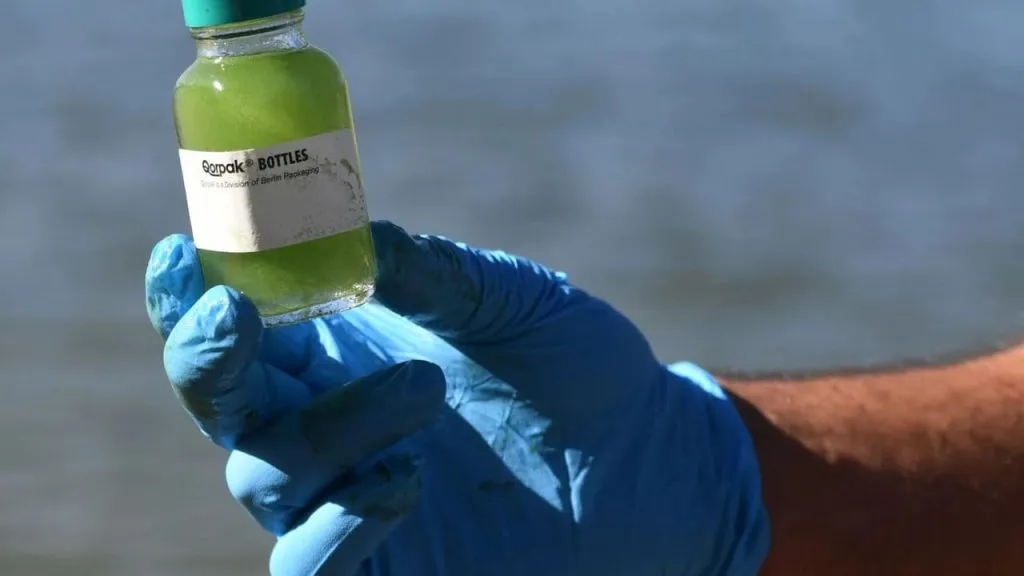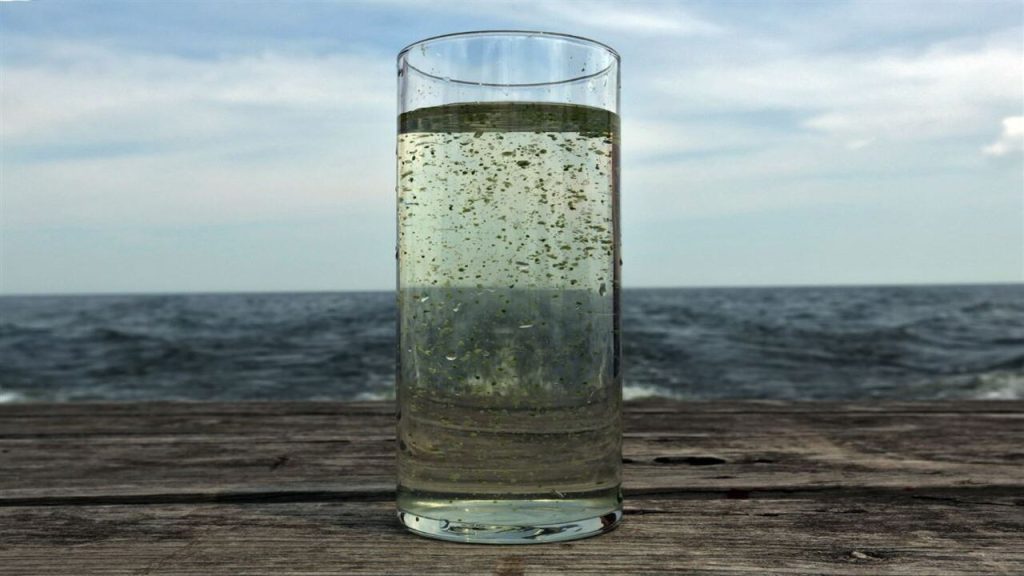As an Amazon Associate I earn from qualifying purchases.
Drinking water’s purity is paramount, ensuring our health and well-being. However, microscopic organisms like algae can occasionally infiltrate this resource, presenting potential concerns.
While certain algae types pose no harm, others can produce toxins detrimental to human health.
This necessitates a comprehensive understanding of algae detection methods and the associated health risks.
This guide explores various testing methods, ranging from traditional enumeration tests to advanced molecular assays.
By understanding these techniques, individuals and authorities can effectively mitigate the risks associated with algae blooms and ensure access to clean, safe drinking water for all.
How to Test For Algae In Drinking Water: The Right Way
Testing for algae in drinking water requires careful consideration of various factors to ensure accurate and reliable results.
While algae may not always be visible to the naked eye, its presence can significantly impact water quality and pose health risks to consumers.
Here’s a detailed overview of the right way to test for algae in drinking water:
1. Sampling Protocol:
Establish a systematic sampling protocol to capture representative samples from different points within the water source.
Ensure that sampling locations cover areas prone to algae growth, such as surface water bodies or reservoirs.
2. Collection Techniques:
Use sterile containers to collect water samples, ensuring minimal risk of contamination during collection and transportation.
3. Enumeration Tests:
Traditional methods for detecting algae involve enumeration tests, where samples are analyzed under a microscope to identify and quantify algae cells.
These tests provide valuable insights into the presence and density of algae populations in the water.
4. Quantitative Polymerase Chain Reaction (QPCR):
Utilize QPCR technology to detect and quantify specific DNA sequences of algae species present in water samples, offering high sensitivity and precision.
5. Enzyme-Linked Immunosorbent Assay (ELISA):
Consider using ELISA assays to swiftly detect algae toxins in drinking water samples, providing rapid and reliable results.
6. Advanced Technologies:
Explore innovative methods such as remote sensing and spectroscopy for non-invasive monitoring of algae blooms in large water bodies, enabling early detection and intervention.
7. Data Analysis and Interpretation:
Analyze test results in alignment with regulatory guidelines to evaluate potential risks associated with algae contamination in drinking water, facilitating informed decision-making for water management.
By following these guidelines and employing appropriate testing methods, individuals, water treatment facilities, and regulatory agencies can effectively monitor and manage algae contamination in drinking water sources.
Let’s now delve into the details of the enumeration test, a traditional method to detect algae in drinking water.
The Algae Enumeration Water Test

The algae enumeration water test is a fundamental method used to assess the presence and density of algae populations in drinking water sources.
Here’s a breakdown of how algae enumeration works:
1. Sampling Procedure:
Water samples are collected from various points in the water source and transported to the lab.
2. Laboratory Analysis:
Technicians examine slides prepared from the samples under a microscope to identify and quantify algae cells.
3. Identification of Algae Species:
Morphological characteristics help identify different algae species present in the sample.
4. Quantification of Algae Density:
Technicians count the number of algae cells per unit volume of water to assess contamination severity.
5. Data Interpretation:
Results are interpreted in line with regulatory guidelines to determine potential health risks.
6. Monitoring and Management:
Regular testing enables early detection of algae blooms, facilitating proactive management strategies to safeguard water quality.
By providing valuable data on algae density and composition, this test enables authorities to safeguard water quality and ensure the delivery of safe drinking water to communities.
Testing for Algae Toxins Using QPCR
Quantitative Polymerase Chain Reaction (QPCR) is a molecular biology technique used to detect and quantify specific DNA sequences of algae species.
Here’s how QPCR is utilized for testing algae toxins:
1. Principle of QPCR:
The QPCR technique relies on the polymerase chain reaction process, which amplifies DNA segments, coupled with fluorescent probes for precise detection and quantification.
2. Target DNA Sequences:
QPCR assays target unique DNA sequences specific to algae species known to produce toxins.
By amplifying these target sequences, QPCR can detect the presence of toxin-producing algae in water samples with high sensitivity and accuracy.
3. Primer Design and Probe Selection:
Specific primers and fluorescent probes are designed to match target DNA sequences of algae toxins.
These primers and probes are carefully selected to ensure they bind only to the target DNA sequences, enhancing the specificity and accuracy of the QPCR assay.
4. Quantification and Analysis:
QPCR monitors the amplification of target DNA sequences in real time, providing quantifiable data on algae toxin presence.
The amount of fluorescence emitted during the amplification process correlates with the initial concentration of target DNA in the sample, allowing for precise quantification.
5. Interpretation of Results:
Authorities assess QPCR results to determine the amount of toxin-producing algae and potential health risks.
High concentrations of algae toxins may indicate the presence of harmful algal blooms.
6. Risk Assessment and Management:
Depending on the severity of algae toxin contamination, measures such as water treatment, public advisories, and environmental monitoring may be implemented to mitigate risks and protect communities.
Testing for algae toxins using QPCR helps ensure the safety of drinking water sources.
Let’s move on to the next section where we’ll learn about the ELISA method of water testing.
Testing for Algae Toxins Through the ELISA Method
Testing for algae toxins through the Enzyme-Linked Immunosorbent Assay (ELISA) method is a straightforward and effective way to detect harmful substances in water samples.
Here’s how it works:
1. Principle of ELISA:
ELISA is a biochemical assay that detects the presence of a specific substance, such as algae toxins, in a sample.
It relies on the interaction between antibodies and antigens, producing a measurable signal to indicate the presence of the target substance.
2. Sample Preparation:
Sample preparation involves extracting and isolating the target toxins from the sample, ensuring that the resulting solution contains the substances of interest.
3. Antibody Binding:
In ELISA, specific antibodies that bind to the target algae toxins are immobilized onto a solid surface, such as a microplate.
When the prepared sample is added to the microplate, any toxins present in the sample will bind to the immobilized antibodies.
4. Detection:
After the sample is incubated, a secondary antibody linked to an enzyme is added.
This secondary antibody binds to the toxins captured by the immobilized antibodies, forming a complex.
5. Quantification:
The intensity of the signal generated is proportional to the concentration of algae toxins present in the sample.
By comparing the signal intensity to standard curves generated from known concentrations of toxins, the concentration of toxins in the sample can be determined.
6. Interpretation of Results:
High levels of toxins detected through ELISA may indicate the presence of harmful algal blooms and potential risks to water quality and human health.
After understanding the methods of testing for algae toxins, let’s delve into the practical tools available for monitoring and detecting harmful algal blooms through our next section.
Sampling Kits for Harmful Algal Blooms

Sampling kits for harmful algal blooms (HABs) are indispensable tools for monitoring and detecting harmful algae in water bodies.
Here are some products that facilitate the detection and analysis of algae toxins:
1. Microcystin Detection Kit (Rapid – Recreational Water):
Attogene’s Microcystin Test Kit swiftly screens for microcystins in water samples at concentrations as low as 6 ppb.
With a format of 10 tests, including 5 tests and 5 controls, this kit offers rapid results within 10 minutes, providing crucial insights into water safety.
2. 5Strands Blue Green Algae Test Kit:
Designed for at-home lake and pond water testing, the 5Strands Blue Green Algae Test Kit offers quick results in just 15 minutes.
This kit empowers users to assess water safety and detect harmful algal blooms conveniently, enhancing environmental awareness and stewardship.
3. Water Test Kit 6-in-1 Swimming Pool, Hot Tub, Pool Testing Kit:
Offering comprehensive testing for swimming pools, hot tubs, and pools, this 6-in-1 Water Test Kit provides accurate measurement of parameters including hardness, total chlorine, and pH.
With easy-to-follow instructions and sample tubes, it ensures reliable pool chemical testing for effective water management.
4. Aquascape 96019 Water Test Kit KH Alkalinity for Pond and Garden Features:
Specifically designed for pond and garden features, the Aquascape 96019 Water Test Kit offers 60 tests to measure KH alkalinity accurately.
With its user-friendly design, this kit enables pond owners to monitor water quality and maintain optimal conditions for aquatic life.
5. EASYTEST 7-Way Pool Test Strips:
These 7-Way Pool Test Strips provide comprehensive water chemical testing for hot tubs and spas.
With 150 strips included, they offer accurate measurement of bromine, total alkalinity, pH, free chlorine, total hardness, cyanuric acid, and total chlorine, ensuring precise water analysis and maintenance.
These sampling kits provide essential tools for monitoring water quality and detecting harmful algal blooms, contributing to the protection of aquatic ecosystems and public health.
What are the Dangers of Algae?
Algae, though often associated with ecological balance, can pose significant dangers when certain species proliferate excessively, leading to harmful algal blooms (HABs).
These blooms can produce toxins harmful to humans, animals, and ecosystems. The dangers of algae include:
1. Toxin Production:
Some algae species, such as cyanobacteria, can produce toxins known as cyanotoxins during blooms.
These toxins, including microcystins and saxitoxins, can contaminate water sources and pose serious health risks to humans and animals if ingested or exposed to skin contact.
2. Water Contamination:
The presence of excessive algae can alter water chemistry, deplete oxygen levels, and disrupt aquatic ecosystems, resulting in fish kills and other adverse environmental impacts.
3. Health Risks:
Exposure to algae toxins can cause health problems in humans, including skin irritation, gastrointestinal illness, respiratory issues, and neurological symptoms.
Vulnerable populations such as children, elderly individuals, and those with compromised immune systems are particularly at risk.
4. Economic Impact:
Harmful algal blooms can have significant economic consequences for communities dependent on affected water bodies for tourism, recreation, and fisheries.
Bloom-related closures of beaches, recreational areas, and shellfish harvesting grounds can result in lost revenue and damage to local economies.
5. Environmental Damage:
Algal blooms can disrupt natural ecosystems by outcompeting other organisms for resources and creating oxygen-depleted dead zones in water bodies.
This can lead to declines in biodiversity, habitat degradation, and long-term ecological consequences for aquatic plants and animals.
Is this Type of Algae a Common Issue?
Harmful algal blooms are becoming increasingly common worldwide, fueled by factors such as nutrient pollution, climate change, and alterations to water flow regimes.
While not all algae species are harmful, certain types, especially cyanobacteria, have become more prevalent due to nutrient runoff from agricultural and urban areas, warmer temperatures, and altered rainfall patterns.
As a result, harmful algal blooms have become a pervasive issue affecting water bodies globally, necessitating proactive management strategies to mitigate their impacts on public health and the environment.
Conclusion
In summary, addressing the risks associated with algae in drinking water requires effective testing methods like algae enumeration, QPCR, and ELISA, along with the use of sampling kits for harmful algal blooms.
The dangers of algae encompass toxin production, water contamination, health risks, economic impact, and environmental damage.
As harmful algal blooms become more prevalent globally, proactive management and mitigation strategies are crucial to protect public health and water resources.
Collaborative efforts are needed to implement sustainable solutions and ensure the availability of safe drinking water for all.
FAQ’s:
Drinking water contaminated with algae or algal toxins can lead to various symptoms, including gastrointestinal issues such as nausea, vomiting, diarrhea, and abdominal pain.
Other symptoms may include skin irritation, respiratory problems, headache, fever, and allergic reactions.
It is not safe to drink water contaminated with algae, especially if it contains harmful algal blooms (HABs) or algal toxins.
Ingesting water with algae or algal toxins can pose significant health risks, including gastrointestinal illness, liver damage, neurological effects, and allergic reactions.
Algae can grow in a wide range of pH levels, but most algae species thrive in slightly alkaline to neutral conditions with pH levels ranging from 7 to 9.
However, some species may tolerate acidic conditions or even thrive in slightly acidic environments.
Algae can exhibit various colors depending on the species and environmental conditions.
Common colors of algae in water include green, blue-green, brown, red, and yellow.
The coloration is often attributed to the presence of pigments such as chlorophyll, carotenoids, and phycobilins.
Algae can produce toxins that cause a range of diseases and health problems in humans and animals.
Some of the diseases caused by algae include paralytic shellfish poisoning (PSP), neurotoxic shellfish poisoning (NSP), amnesic shellfish poisoning (ASP), ciguatera fish poisoning (CFP), and cyanobacterial intoxications, among others.
These diseases can result from consuming contaminated seafood or water containing algal toxins.
Amazon and the Amazon logo are trademarks of Amazon.com, Inc, or its affiliates

